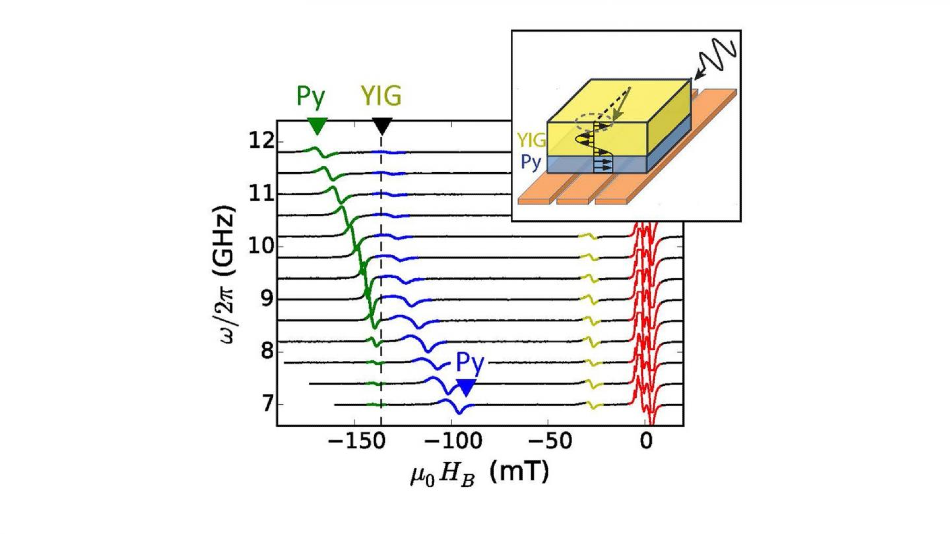Apr 28 2020
Researchers have started to investigate the behavior of magnetic and electronic spins, particularly their resonant excitations, as information carriers in an attempt to find new methods to process and transmit data.
 Researchers at Argonne have found a new platform for coherent information transduction with magnons in an exchange-coupled magnetic thin film bilayer. The results show new insights in both fundamental physics and device potentials for spintronics and quantum applications. Image Credit: Argonne National Laboratory.
Researchers at Argonne have found a new platform for coherent information transduction with magnons in an exchange-coupled magnetic thin film bilayer. The results show new insights in both fundamental physics and device potentials for spintronics and quantum applications. Image Credit: Argonne National Laboratory.
In certain cases, scientists have discovered novel phenomena that could help create new devices for quantum and spintronic applications.
As part of a new study under the guidance of the U.S. Department of Energy’s (DOE) Argonne National Laboratory, scientists have devised a new method for firmly coupling the excitations of magnetic spins in two distinct thin films to each other through their common interface.
Such a dynamic coupling is one form of hybrid system that has gained considerable attention from researchers focused on quantum information systems.
One way to think about it is as though you have two pairs of masses attached to springs. We know that each mass connected to a spring will oscillate periodically when it’s hit from the outside.
Yi Li, Study First Author and Postdoctoral Researcher, Argonne National Laboratory
Li continued, “But if we connect the two masses with a third spring, then the oscillation of one mass will also trigger the oscillation of the other mass, which can be used to exchange information between the springs. The role of the third spring here is played by the interfacial exchange coupling between the two magnetic layers.”
With some clever designing, scientists can make the free oscillation frequency of the two layers of magnetic spins—the “masses”—identical, making them the most favorable to couple. Additionally, they demonstrate that it is possible to “strongly” couple the two systems, a state essential to keep coherence and may support applications in quantum information.
Apart from the strong-coupling state, the team has identified an additional new effect in the magnetic bilayer, which influences the coherence of their excitations—one side of the layer can pump energy, known as spin current, into the other one.
One interesting and remarkable behavior regarding the new dynamic coupling is the energy exchange between the two layers in the magnetic material.
Axel Hoffmann, one of the authors of the study and a materials scientist at the University of Illinois, noted that every layer presents a specific length of time over which the magnetization dynamics will often persist individually.
But when the spin current is introduced, it forces the spins in a specific direction, thus leading to the transfer of sufficient energy so that the magnetization dynamics last for a considerably longer time in one of the layers.
We knew that a rigid kind of coupling existed, but the fact is that the other dynamic coupling is also important—and important enough so that we can’t neglect it. For quantum information systems, the name of the game is to take some excitation and to manipulate it in some way or transfer it to another excitation, and that’s pretty much at the heart of what we’re doing here.
Yi Li, Study First Author and Postdoctoral Researcher, Argonne National Laboratory
Li added, “There is an intrinsic magnetic interaction that couples these two layers. We can apply a magnetic field, and then we can determine whether these two layers are pumping in phase or out of phase. Such controlled interactions are in principle what people are doing for quantum information processing.”
The experiment began by identifying two magnetic systems that were known to be coupled, said Hoffmann. The researchers sought to make the coupling as robust as possible when compared to the separate excitations in the material. Thus, they could gain additional insight into how the transfer of spin pumping energy took place.
A paper on the study, titled “Coherent spin pumping in a strongly coupled magnon-magnon hybrid system,” was published in Physical Review Letters, in the March 17th issue.
The additional authors of the study are Argonne’s Zhizhi Zhang, Jonathan Gibbons, John Pearson, Valentine Novosad, and Wei Zhang; Paul Haney, Mark Stiles, and Vivek Amin of the National Institute of Standards and Technology; Wei Cao and William Bailey of Columbia University; and Joseph Sklenar of Wayne State University.
The Argonne part of the study was financially supported by the DOE’s Office of Science.
Journal Reference:
Li, Y., et al. (2020) Coherent Spin Pumping in a Strongly Coupled Magnon-Magnon Hybrid System. Physical Review Letters. doi.org/10.1103/PhysRevLett.124.117202.